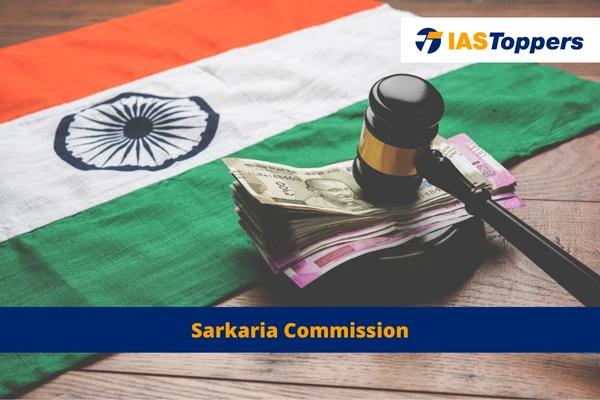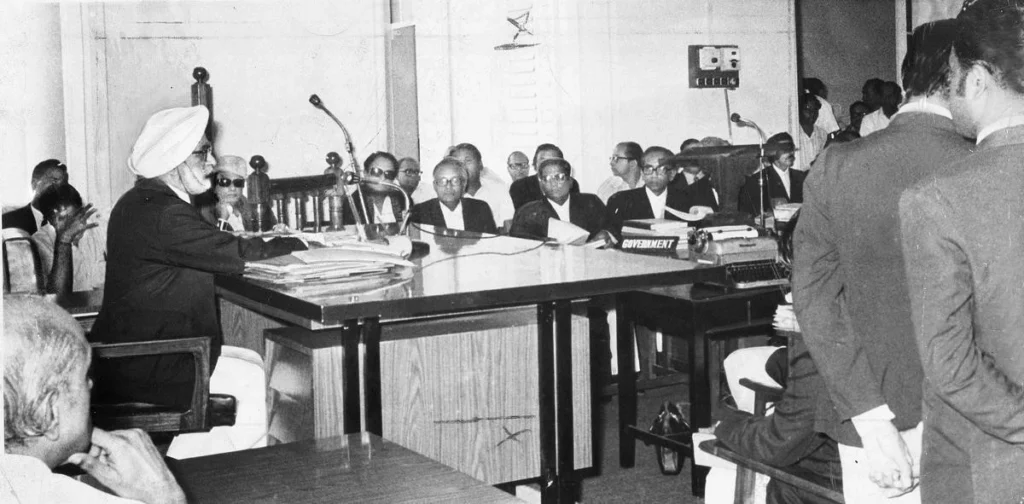The Sarkaria Commission was formed by the Indian government in 1983, and aimed to evaluate and reassess the existing Union-State arrangements. It was headed by R.S. Sarkaria. It focused on proposing necessary changes within the framework of the Constitution to uphold unity, independence, and the welfare of the people.
Sarkaria Commission will be helpful for UPSC IAS Exam preparation. GS Paper-2 Indian Polity.
Table of Content
- What is Sarkaria Commission?
- Purpose of Sarkaria Commission
- Sarkaria Commission Report
- Recommendations of the Sarkaria Commission
- Conclusion
- Frequently Asked Questions (FAQs)
What is Sarkaria Commission?
- The Indian government formed a three-member Commission in 1983 known as Sarkaria Commission.
- Members: It was headed by R.S. Sarkaria, a retired judge of the Supreme Court, with Shri B. Sivaraman, and Dr. S.R. Sen as its members.
- Initially given a one-year timeframe, the commission’s work was extended four times, and Sarkaria Commission finally submitted its report in 1988.
Purpose of Sarkaria Commission
- The Commission is tasked with evaluating and reassessing the current Union-State arrangements across various domains.
- It will propose necessary changes considering social and economic advancements and the Constitution’s framework, designed to protect independence, unity, and the well-being of the people.
- The Commission’s mandate involves a thorough assessment of Union-State arrangements, followed by recommendations aligned with the nation’s current needs.
- This approach prioritizes people’s welfare while upholding principles of national unity and integrity.
Sarkaria Commission Report
- The report by the Sarkaria Commission consists of two sections.
- The initial section comprises the primary report, while the subsequent section focuses on the memoranda submitted by political parties and state governments.
- This comprehensive report delves into the realm of administration and legislation, specifically addressing inter-governmental relations.
It emphasizes the importance of establishing an inter-state council to facilitate seamless coordination among governments. - Within its 19 chapters, the Sarkaria Commission report puts forth a total of 247 recommendations.
Recommendations of the Sarkaria Commission
Here are some of the important recommendations of the Sarkaria Commission:
Legislative Recommendations
- Retention of Parliament’s authority over residual powers of taxation, while placing other residual powers in the Concurrent List.
- Necessity of Parliament’s demand before setting up a commission of inquiry against a state minister.
- Communication of reasons by the President when withholding assent to state bills.
- Maintenance of the current role of Rajya Sabha (Council of States) and the Centre’s power to reorganize states.
Recommendations on Centre-State Relations
- Establishment of a permanent Inter-State Council, known as the Inter-Governmental Council, under Article 263.
- Limited use of Article 356 (President’s Rule) as a last resort in extreme cases when all other alternatives fail.
- Fresh constitution and reactivation of zonal councils to promote federalism.
- Authority for the Centre to deploy armed forces without state consent while consulting with the states when possible.
- Prior consultation of states by the Centre when legislating on Concurrent List subjects.
- Permissible sharing of net proceeds from corporation tax with the states.
- Levying of surcharge on income tax by the Centre only for specific purposes and within a limited timeframe.
- Continuation of the current division of functions between the Finance Commission and the Planning Commission.
- No autonomy for radio and television, but decentralization in their operations.
Administrative Recommendations
- Strengthening of the All-India Services and creation of additional such services.
- Activation of the commissioner for linguistic minorities.
- Uniform implementation of the three-language formula.
- Renaming and reconstitution of the National Development Council (NDC) as the National Economic and Development Council (NEDC).
Recommendations on Governor
- Inclusion of the procedure for consulting the Chief Minister in the appointment of state governors in the Constitution itself.
- Preservation of the five-year term for state governors, except in exceptional circumstances.
- Prohibition of the Governor from dismissing the council of ministers as long as it enjoys majority support in the assembly.
The government has implemented 180 out of the 247 recommendations made by the Sarkaria Commission.
Notably, the establishment of the Inter-State Council in 1990 stands as one of the most significant outcomes of the commission’s recommendations.
Conclusion
The Sarkaria Commission’s report was submitted in 1988 with 247 recommendations. The Commission’s proposals have played an important role in shaping legislative, administrative, and governance practices in India. The implementation of 180 out of 247 recommendations, including the establishment of the Inter-State Council, highlights the significance of the Sarkaria Commission’s work in promoting effective Union-State coordination.
Refer to the linked article to know about Punchhi Commission.
Ref: Source-1
FAQs (Frequently Asked Questions)
What were the main recommendations of Sarkaria Commission?
Sarkaria Commission gave recommendations on Governor, Centre-State Relations, Legislation, etc.
When was the Sarkaria Commission gave its final report?
Sarkaria Commission gave its final report in 1988.
Who appointed the Sarkaria Commission?
Prime Minister Smt. Indira Gandhi appointed Sarkaria Commission. It was headed by R.S. Sarkaria, a retired judge of the Supreme Court.
When was Sarkaria Commission set up? Or when was Sarkaria Commission formed?
The Sarkaria Commission was set up in the year 1983.
What was the Sarkaria Commission related to?
Sarkaria Commission was related to examine the relationship and balance of power between state and central governments in the country.



